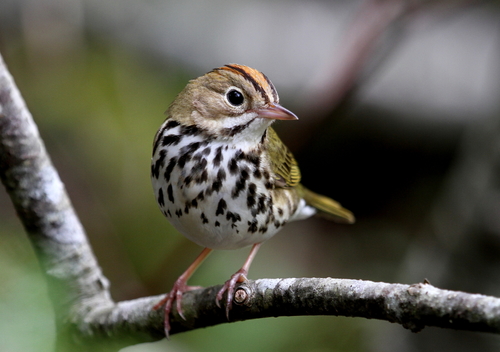
Ovenbird
The Ovenbird (Seiurus aurocapilla) is a small songbird of the New World warbler family (Parulidae). It is known for its distinctive, loud, ringing song, often described as sounding like "teacher, teacher, TEACHER." Unlike many warblers, the Ovenbird is relatively inconspicuous, spending much of its time foraging on the forest floor. Its name comes from the unique, dome-shaped nest it builds, resembling an old-fashioned outdoor oven. Ecologically, Ovenbirds play a crucial role in controlling insect populations within their forest habitats. While not of major cultural significance, they are a cherished indicator species for forest health.
11-16 cm
Length
19-26 cm
Wingspan
Least Concern
Conservation Status
Distribution
The Ovenbird breeds across much of North America, from the eastern United States and Canada west to the Rocky Mountains and British Columbia. During winter, it migrates to the southeastern United States, Mexico, Central America, the Caribbean, and northern South America. Its altitudinal range extends from sea level to mountainous regions, depending on location.
Lifespan
Up to 11 years in the wild (based on banding records), typically shorter.
Ovenbird's Habitat
Habitat Types
Deciduous forests, Mixed forests, Mature forests with closed canopies
Climate Zones
Temperate, Boreal
Adaptations
The Ovenbird's terrestrial lifestyle is supported by strong legs and feet, adapted for walking and running on the forest floor rather than perching. Its coloration provides camouflage amongst leaf litter.
Variations
Three subspecies are generally recognized, differing slightly in plumage coloration and size: *S. a. aurocapilla*, *S. a. cinereus*, and *S. a. furvior*.
Appearance
Breeding Plumage
Plumage is relatively consistent year-round.
Seasonal Feather Changes
Minimal seasonal variation.
Sex Based Plumage Differences
Males and females have similar plumage.
Notable Features
Olive-brown upperparts, White underparts with bold black streaking, Orange crown stripe bordered by black, White eye-ring
Diet and Feeding
Primary Foods
Insects, Spiders, Other invertebrates, Occasionally small amphibians and seeds
Foraging Behavior
Ovenbirds primarily forage on the ground, walking and flipping over leaves to find prey. They may also glean insects from low vegetation.
Specializations
Their strong legs and relatively long bill are well-suited for foraging in leaf litter.
Seasonal Diet Variations
Diet shifts slightly depending on prey availability, but remains primarily insectivorous year-round.
Behavior
Social Structure
Generally solitary or in pairs during the breeding season. May form loose flocks during migration.
Communication
Loud, ringing "teacher, teacher, TEACHER" song, Sharp "chip" call notes, Visual displays during territorial disputes
Migration
Ovenbirds are long-distance migrants, traveling at night. They use a combination of celestial cues, magnetic fields, and landmarks for navigation.
Territorial or Group Behaviors
Males are highly territorial during the breeding season, defending their nesting area from rivals.
Conservation
Threats
Habitat loss and fragmentation (due to deforestation and development), Collisions with buildings and windows during migration, Pesticide exposure, Climate change (potentially affecting habitat and prey availability)
Protection Programs
Habitat conservation initiatives, Efforts to reduce bird-building collisions, Monitoring programs (e.g., Breeding Bird Survey)
Local National Laws
Protected under the Migratory Bird Treaty Act in the United States.
Population Trend
Generally stable, although some regional declines have been noted.
Population Estimates
Global population estimated to be around 48 million.
Interesting Facts
Ovenbirds walk rather than hop.
This is unusual for a warbler, reflecting their ground-foraging habits.
Their domed nests are exceptionally well-camouflaged.
This helps protect the eggs and chicks from predators.
Ovenbirds are known to be sensitive to forest fragmentation.
They require large, contiguous tracts of forest for successful breeding.
Faqs about Ovenbird
What does an Ovenbird sound like?
The Ovenbird has a loud, ringing song that sounds like "teacher, teacher, TEACHER," repeated multiple times.
Where can I find an Ovenbird?
Look for Ovenbirds in mature deciduous or mixed forests, particularly during the breeding season. Listen for their distinctive song, and scan the forest floor.
Are Ovenbirds endangered?
No, Ovenbirds are currently listed as Least Concern by the IUCN, but they face threats from habitat loss and other factors.
Do Ovenbirds reuse their nests?
No, Ovenbirds will build a new nest each year.
Copyright @ Nature Style Limited. All Rights Reserved.
 English
English